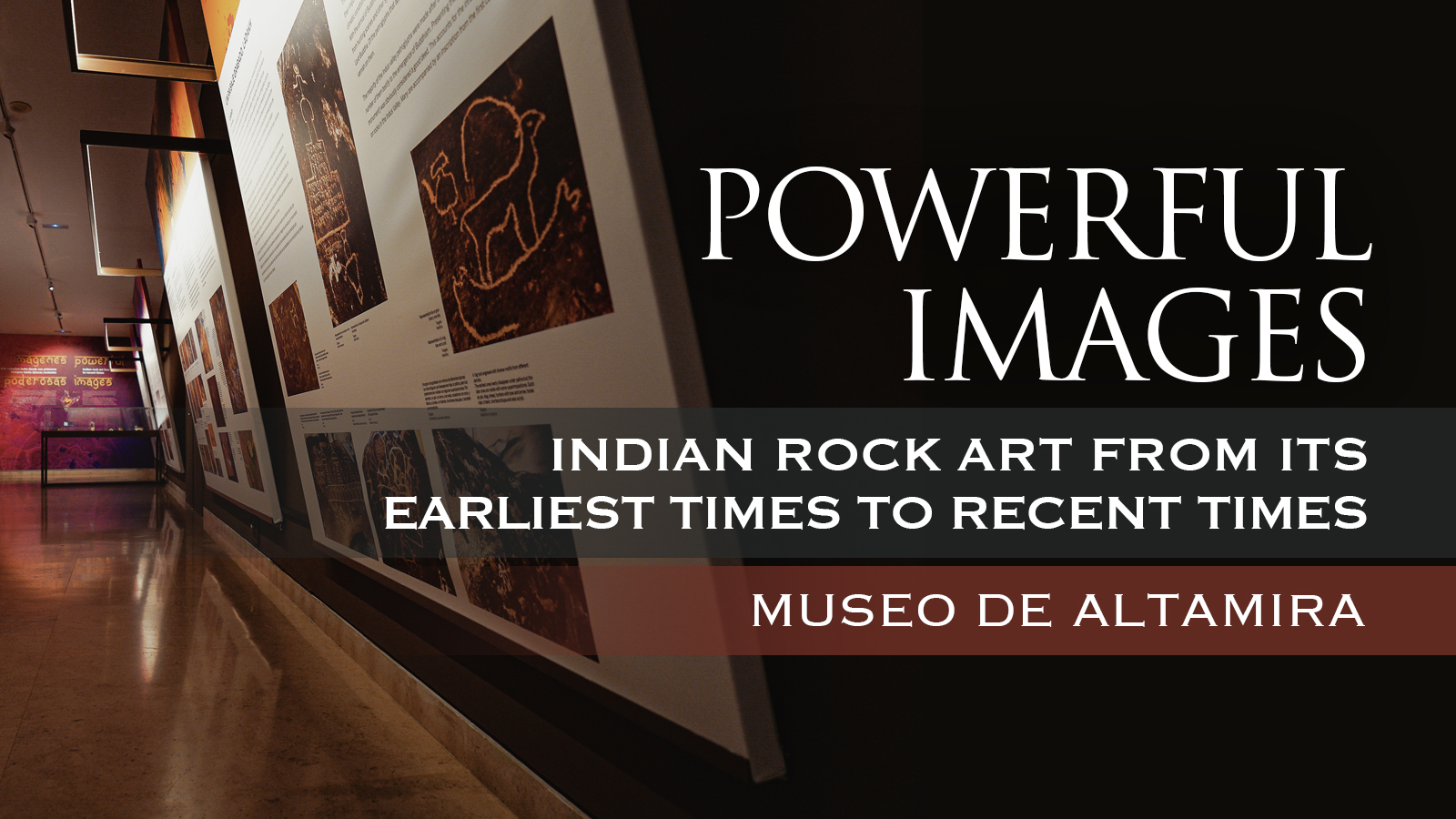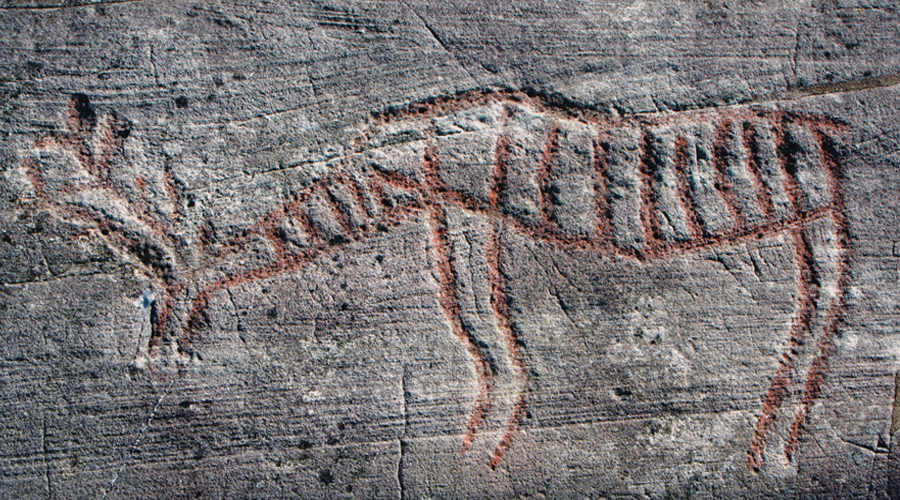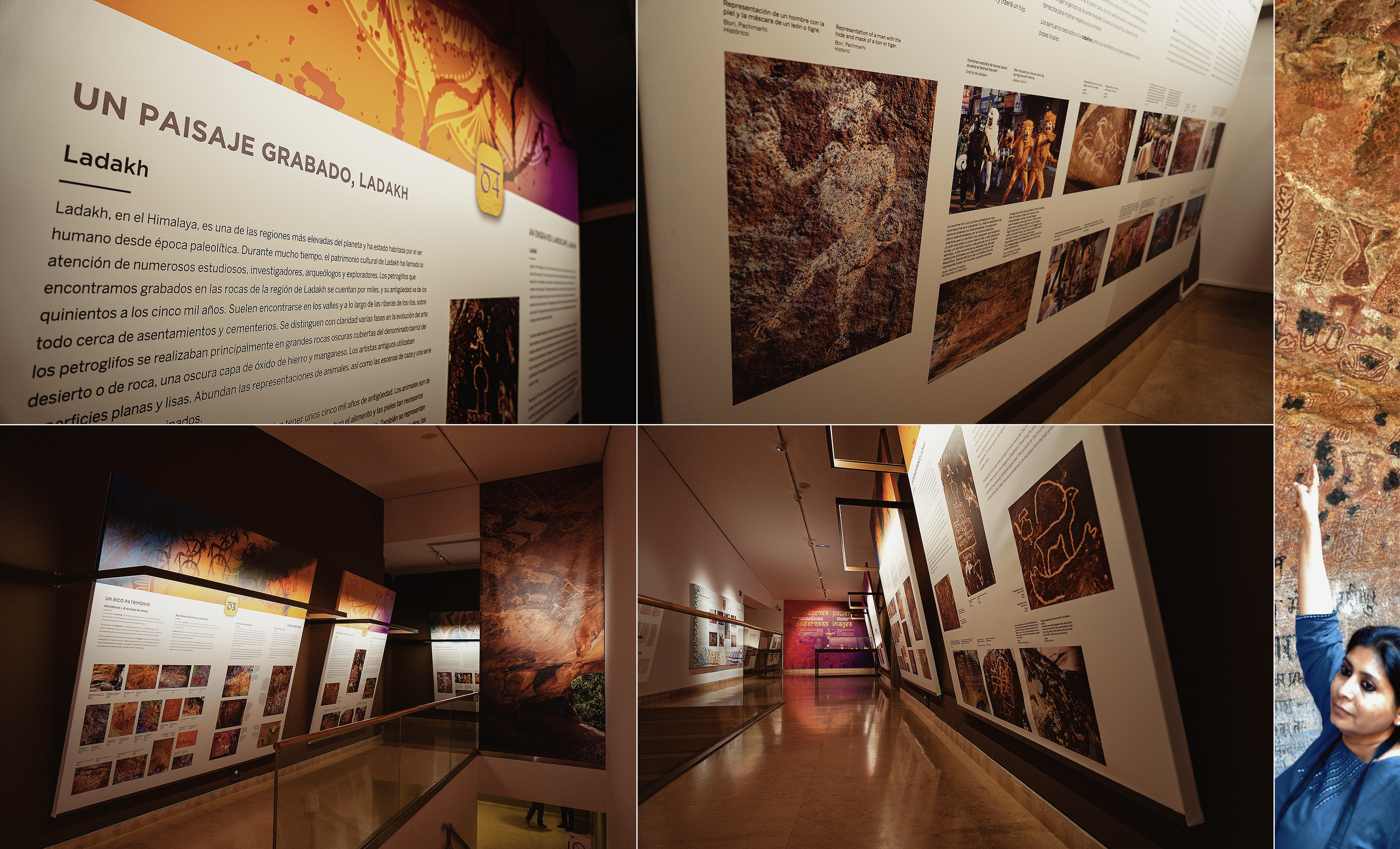



These shelters were used from the Stone Age by the first people, maintaining their occupation until later periods, and depicting animal and human representations and signs on walls and ceilings. When art first appeared, it appeared full-blown in a technically and aesthetically sophisticated fashion.
Organiza | Organized
Museo Nacional y Centro de Investigación de Altamira | Ministerio de Cultura y Deporte
Financia | Funding
Subdirección General de Museos Estatales | Ministerio de Cultura y Deporte
Comisaria | Curator
Meenakshi Dubey-Pathak, investigadora independiente y experta en arte rupestre Independent Rock Art Researcher and Expert, Bhopal
Coordinadora | Coordinator
Pilar Fatás (Museo de Altamira)
Imágenes | Photos
Meenakshi Dubey-Pathak
Vishnu Shreedhar Wakankar
Dibujos | Drawing
J. Cockburn
F. Fawcett
C.W. Anderson
D.H. Gordon
Gestión documental | Documentation Management
Maricer González (Museo de Altamira)
Ana López Pajarón (Museo Nacional de Antropología)
Diseño | Design
Nexo
Montaje | Installation
Serisan
Transporte | Transport
SIT
Seguro | Insurance
Correduría: Poolsegur
Aseguradora: Scor Europe S.E.
Agradecimientos | Acknowledgments
Indian Army for Exploring Ladakh area
The Forest Department of Madhya Pradesh State
The Forest Department of Chhattisgarh State
The Culture Department (Raipur, Chhattisgarh)
Wakankar Research Institute (Bhopal, Madhya Pradesh)
INTACH (Indian National Trust for Art, Culture and Heritage) New Delhi
Fernando Sáez Lara, Ana López Pajarón y Ana Gracia Rivas (Museo Nacional de Antropología)
Y especialmente a | And especially to
Vishnu Shreedhar Wakankar, Jean Clottes (France), Vivek Dhand (Chief Secretary, Raipur), Rakesh
Chatuervedi (Chairman, Bio Diversity, Raipur), Amru, Lakshmi, Mohan, Netam, Prabhat, Bhodumal,
Ajay, Jitendra, Sonam, Om Prakash, Luv Shekhawat, Abhimanyu, Kushagra and all people from
different villages.
Esta exposición es fruto de la colaboración establecida en el marco de la red Rock Art Network creada por el Getty Conservation Institute y la Bradshaw Foundation.
This exhibition is the result of the collaboration in the framework of the Rock Art Network, formed by the https://www.getty.edu/conservation/ and the Bradshaw Foundation.
New publication Powerful Images: Chhattisgarh Rock Art & Tribal Art by Meenakshi Dubey-Pathak & Jean Clottes.
Discover more about the Rock Art of India.
→ Members and affiliated institutions of the Rock Art Network
by
George Nash
5/09/2024 Recent Articles
→ Sigubudu: Paintings of people with guns in the northern uKhahlamba-Drakensberg
by Aron Mazel
22/07/2024
by Richard Kuba
13/06/2024
by Meenakshi Dubey-Pathak
8/03/2024
by Rock Art Network
6/02/2024
by Rock Art Network
14/12/2023
by Sam Challis
5/12/2023
by Aron Mazel
30/11/2023
by Sam Challis
21/11/2023
by Sam Challis
15/11/2023
by Sam Challis
10/11/2023
by Rock Art Network
6/11/2023
by Rock Art Network
3/11/2023
by Aron Mazel
2/11/2023
by Meenakshi Dubey-Pathak
26/09/2023
by Paul Taçon
24/08/2023
by Aron Mazel
13/06/2023
by Paul Taçon
5/06/2023
by Paul Taçon
15/03/2023
by George Nash
14/03/2023
by Noel Hidalgo Tan
10/02/2023
by George Nash
01/02/2023
by Meenakshi Dubey-Pathak, Pilar Fatás Monforte
29/11/2022
by Aron Mazel, George Nash
21/09/2022
by Paul S.C. Taçon, Sally K. May, Ursula K. Frederick, Jo McDonald
07/07/2022
by Meenakshi Dubey-Pathak
26/07/2022
by Paul Taçon
20/07/2022
by David Coulson
16 June 2022
by Paul Taçon
25 April 2022
by Noel Hidalgo Tan
20 April 2022
by Meenakshi Dubey-Pathak
14 March 2022
by Carolyn Boyd & Pilar Fatás
02 March 2022
by David Coulson
07 February 2022
by Johannes H. N. Loubser
06 February 2022
by Meenakshi Dubey-Pathak
05 February 2022
by Aron Mazel
28 January 2022
by Aron Mazel
8 September 2021
by David Coulson
17 August 2021
by Ffion Reynolds
21 June 2021


by Aron Mazel
22/07/2024
by Richard Kuba
13/06/2024
by Meenakshi Dubey-Pathak
8/03/2024
by Rock Art Network
6/02/2024
by Rock Art Network
14/12/2023
by Sam Challis
5/12/2023
by Aron Mazel
30/11/2023
by Sam Challis
21/11/2023
by Sam Challis
15/11/2023
by Sam Challis
10/11/2023
by Rock Art Network
6/11/2023
by Rock Art Network
3/11/2023
by Aron Mazel
2/11/2023
by Meenakshi Dubey-Pathak
26/09/2023
by Paul Taçon
24/08/2023
by Aron Mazel
13/06/2023
by Paul Taçon
5/06/2023
by Paul Taçon
15/03/2023
by George Nash
14/03/2023
by Noel Hidalgo Tan
10/02/2023
by George Nash
01/02/2023
by Meenakshi Dubey-Pathak, Pilar Fatás Monforte
29/11/2022
by Aron Mazel, George Nash
21/09/2022
by Paul S.C. Taçon, Sally K. May, Ursula K. Frederick, Jo McDonald
07/07/2022
by Meenakshi Dubey-Pathak
26/07/2022
by Paul Taçon
20/07/2022
by David Coulson
16 June 2022
by Paul Taçon
25 April 2022
by Noel Hidalgo Tan
20 April 2022
by Meenakshi Dubey-Pathak
14 March 2022
by Carolyn Boyd & Pilar Fatás
02 March 2022
by David Coulson
07 February 2022
by Johannes H. N. Loubser
06 February 2022
by Meenakshi Dubey-Pathak
05 February 2022
by Aron Mazel
28 January 2022
by Aron Mazel
8 September 2021
by David Coulson
17 August 2021
by Ffion Reynolds
21 June 2021
Friend of the Foundation


by Aron Mazel
22/07/2024
by Richard Kuba
13/06/2024
by Meenakshi Dubey-Pathak
8/03/2024
by Rock Art Network
6/02/2024
by Rock Art Network
14/12/2023
by Sam Challis
5/12/2023
by Aron Mazel
30/11/2023
by Sam Challis
21/11/2023
by Sam Challis
15/11/2023
by Sam Challis
10/11/2023
by Rock Art Network
6/11/2023
by Rock Art Network
3/11/2023
by Aron Mazel
2/11/2023
by Meenakshi Dubey-Pathak
26/09/2023
by Paul Taçon
24/08/2023
by Aron Mazel
13/06/2023
by Paul Taçon
5/06/2023
by Paul Taçon
15/03/2023
by George Nash
14/03/2023
by Noel Hidalgo Tan
10/02/2023
by George Nash
01/02/2023
by Meenakshi Dubey-Pathak, Pilar Fatás Monforte
29/11/2022
by Aron Mazel, George Nash
21/09/2022
by Paul S.C. Taçon, Sally K. May, Ursula K. Frederick, Jo McDonald
07/07/2022
by Meenakshi Dubey-Pathak
26/07/2022
by Paul Taçon
20/07/2022
by David Coulson
16 June 2022
by Paul Taçon
25 April 2022
by Noel Hidalgo Tan
20 April 2022
by Meenakshi Dubey-Pathak
14 March 2022
by Carolyn Boyd & Pilar Fatás
02 March 2022
by David Coulson
07 February 2022
by Johannes H. N. Loubser
06 February 2022
by Meenakshi Dubey-Pathak
05 February 2022
by Aron Mazel
28 January 2022
by Aron Mazel
8 September 2021
by David Coulson
17 August 2021
by Ffion Reynolds
21 June 2021
Friend of the Foundation
















